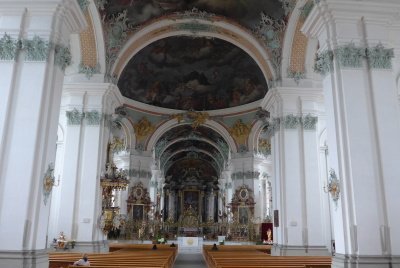
This is a site with rather strange OUV which you can partially excuse or explain because it was such an early nomination:
Like the Reichenau this was one of the most important (and powerful) monasteries of medieval Europe with a great and widespread territory, one of the most important collections of manuscripts and books in the world and a famous writing workshop. It also lends its name to the most important architectural plan of the middle ages: the St. Gall monastery plan.
So far, so great. The problem is that not much of that contributes really its OUV: The church and the monastery nowadays are completely baroque and therefore not from the time when the monastery was at its peak but built far later. While this complex of buildings is grand and impressive it is in the whole not better or grander then a considerable number of great monasteries that were rebuilt in the baroque era, especially in southern Germany and Austria. The church has been restored a few years ago and I find the color scheme rather disturbing though it is supposed to refer to the original colors: While most ornaments have strange combination of turquoise and orange the large painting in the cupolas are still extremely dark like darkened by centuries of candle soot even after the restoration.
The only part that may have OUV as a building is the famous and wonderful library but even this has strong competition by a number similar baroque libraries, many of them also in monasteries. Some of the are inscribed like the great baroque libraries in Vienna and Prag. Of the medieval buildings are only two crypts left, as far as I now, and they are rarely open and difficult to visit and as far as I can tell from fotos they are simple structures.
The collection of books is still extremely important but is movable and should not contribute to the OUV.
The famous monastery plan is in the monastery museum and can be seen in the original. But it is certain that the plan was not drawn in St. Gallen but on the island of Reichenau! As a movable item it doesn't contribute to the physical OUV of the site in any case.
The larger part of the current complex is not accessible for the public: It is still a living monastery and in addition a school and a seat of government. Therefore you can basically visit the cathedral, the library and the basement with the museum. The latter has improved dramatically since a few years: It has been enlarged and you can visit the original monastery plan in a climatized room and there are good changing exhibitions (at least the one I saw was very good). Almost half of the complex is used by the cantonal government and I while I doubt they have real OUV they seem to include several interesting historicist rooms. As a WHS they should of course be accessible to the public but haven't been open for years, at least since I checked for tours. Fortunately I saw recently that now there seem to be regular tours on weekends and I planning to make use of that opportunity as soon as I have the chance.
In the whole, perhaps apart from the library, the monastery seems more inscribed for what it was at a time then for what you can see today, a fact that it shares, as a stated in the beginning, with the Reichenau monastery and several other sites. A visit is still interesting and worthwhile, not only for the library and the good museum but also for the beautiful old town around the monastery, famous for its magnificent oriels. Around the old town you find several splendid historicist and art nouveau buildings since St. Gall had world famous textil industry and very rich at the beginning of the 20th century. The central station seems the modern counterpiece to the baroque cathedral.
More on
Comments
No comments yet.
